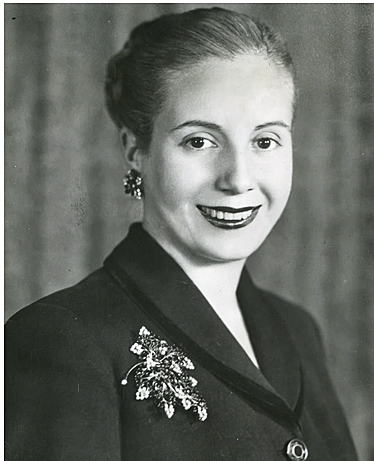
- Articles
A conversation between Drs. Daniel E. Nijensohn and Adam R. Bogart about Argentinean politics and Evita Perón’s secret lobotomy
This conversation should be of interest not only to neurosurgeons and neuroscientists, but also political and social scientists, as well as the well-informed segment of the general public, and not just in Argentina but also throughout the world.
Dr. Daniel Nijensohn has performed a great service to medical history and neuroscience ethics with his outstanding investigation of Evita Perón’s secret prefrontal lobotomy and analyzing the implications of such a procedure, particularly on a public figure of her political stature. I also agree with him that human acts must be judged not only by transcendental morality tempered by place and special circumstances. I always suspected that Evita’s lobotomy, a bizarre episode with which I first became acquainted from Dr. Nijensohn, et al.’s paper, was performed to alleviate her pain, depression, anxiety, and pacify her agitation in such a powerful and idolized personality, but Dr. Nijensohn’s follow up research has provided more persuasive evidence that political considerations also played a pivotal role, convincing President Juan Perón that her lobotomy was necessary to protect his regime, as Evita had held the descamisados (“shirtless ones”) in high pitch while becoming more militant and belligerent as her condition worsened and the advanced cervical cancer threatened her personal survival.

In a preliminary conversation with Dr. Adam Bogart, who actually aroused my interest about this bizarre chapter in medical and political history, he wrote:
“…my suspicions are despite her uneducated and naïve worldview, she was actually a far better politician than Juan Perón. Though he would never say so, it could be he married her in part to learn politics from her. Evidence suggests that their marriage was affectionate but loveless, and that all who met Evita commented on her absolute lack of sex appeal. If all of this is true, she was quite a political threat to him, even when dying. She was never told of the diagnosis or prognosis, but likely she figured out on her own that she did not have much time left to implement her own program.”
I agree with some of this assessment, particularly the last two sentences, but I’m less convinced that she was not told of her terminal condition. I also doubt that “her absolute lack of sex appeal.” I believe Perón was infatuated with the struggling actress with political inclinations, not unlike emperor Justinian was infatuated with his Theodora, and both Julius Caesar and Marc Antony were enthralled with Cleopatra, despite her unprepossessing beauty. — Dr. Miguel A. Faria, Friday, June 22, 2018
______________
Tuesday, May 29, 2018
Dear Dr. Bogart,
Thank you very much for your note regarding my work on Evita Perón’s secret prefrontal lobotomy. I read with interest and attention your comments. The evaluation of the skull x-ray images extracted from the documentary was just the start of a long process that amply confirmed the fact that Evita did undergo a lobotomy a few weeks before her death. I also found that it was done by Dr. James L. Poppen from Boston, ordered by General Juan Perón, secretly performed at the presidential mansion, with armed bodyguards present in the bedroom turned into an operating room. Dr. Pedro Ara, the Spanish anatomist/embalmer, described quite clearly in his book about Evita the scalp/skull indentations of the trephinations behind her hairline. Further work and evidence starting with the declarations of Dr. George Udvarhelyi led me to conclude that the operation was performed not only for intractable pain relief from metastatic cervical cancer, but also to change behavior and personality. Evita was the leader of the left wing of the party and Juan Perón later admitted he was afraid of her and of her followers. She purchased weapons from the “Black Prince” of the Netherlands and was training militias in northeast Argentina with the purpose of “bringing down” the government of her husband and initiating a “true revolution.” Argentina went through a civil war in the 70s and the political divisions in Argentina are still felt to this day, way into the 21st Century.
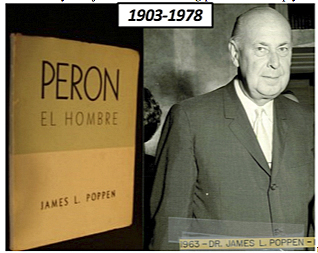
Without the imaging we enjoy today, i.e., CT scanning of the head, MRI of the brain, and others, it is difficult to ascertain what else was going on in Evita’s head/brain. My clinical impression, from discussing the case with Dr. Poppen’s scrub nurse and others, is that Evita died, a few weeks after the lobotomy, from starvation. She refused to eat after the procedure. I do not think it was as a result of a brain hemorrhage but a side effect of the lobotomy. Back then, we did not know of IV hyperalimentation and although she could have been forced fed through nasogastric tubing, I doubt this would have been considered in view of the enormous amount of attention she received, and the political implications back then. Dr. Poppen’s nurse confided that he was very upset and unhappy with the poor results of his surgical intervention. Evita continued to complain of pain, stopped eating and became emaciated, which weakened her further and led to her death in July, 1952. Dr. Poppen remained confused about the nature of the Perónist regime and wrote, without apparent coercion, a panegyric of General Perón’s political regime. Eventually, though, his naiveté was replaced with the understanding that he had been an instrument of a very savvy and labyrinthian political Latin American system. The sad part of it is that Dr. Poppen, then considered one of the best neurosurgeons in the world, aided in carrying on a sinister plan that included the lobotomy of a few political prisoners, performed in the jails of Buenos Aires…
As you can see from the enclosed, I will be a visiting professor in Ottawa, Canada, and on Friday, June 15, 2018, at the Civic Amphitheater I will be discussing this story in depth. It is open to the public and you are most welcome to attend.
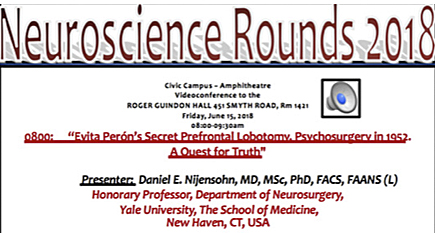
I read with interest your thoughts about Lenin’s and Stalin’s medical conditions and look forward to read more of your contributions to medical history. Best regards, Dr. Daniel Nijensohn
______________
Monday, June 4, 2018
Dear Dr. Nijensohn,
I had to reread this several times, as the story is complex. I see how Dr. James L. Poppen could have been naïve about what was really going on until much later. Since lobotomy was performed in the USA at that time for violent prisoners (as we had no political ones) he likely was not told he was operating on political prisoners. If he had been told that, I don’t know enough about him to say what he would have done. Now I see that Perón and his cronies likely lied to Dr. Poppen about the crimes of these prisoners. Dr. Poppen was an excellent neurosurgeon, as you say. He did not need to practice on anyone, so I imagine Perón wanted to see for himself what Poppen’s operations would do to the prisoner’s political expression. The lobotomy results on the prisoners must have been to Perón’s liking, if he then allowed Poppen to proceed with Evita.
Also, I stated I thought she had a generalized anhedonia. I thought that because the way lobotomy worked has always interested me, as it seemed to produce effects that are in many ways similar to modern psychopharmacological agents. For instance, when employed to treat severe obsessive-compulsive disorder (OCD), if the lobotomy was “successful,” the patient would still have the obsessions, but would not be upset by them, similar to the way patients with pain from cancer lost their emotional reaction to the pain, even though the pain remained. They simply were not bothered by it. Nowadays, both older classical antidepressants and the newer selective serotonic reuptake inhibitors (SSRIs) can be used to treat obsessive-compulsive disorder and pain in higher dosages. But even here, the patient usually reports more of an indifference to the pain or obsessions than a reduction of the symptoms themselves. Typically though, eating is increased.

So it occurred to me that since reaction to pain and desire to eat are both primitive neural mechanisms for survival (and obsessions likely have much of their origins in the basal ganglia, which are fairly old structures) that if a problem with Evita’s operation might have amplified the intensity of the effects of the lobotomy — causing indifference to very old survival instincts which are pleasurable to fulfill — like eating. The lower mammals would not have much control over these instincts, but while it can be difficult, humans can resist at least some of them. Do you know if Evita had any desire to drink after the lobotomy? The problem with my theory is that you mentioned she still complained of pain. If she did, then the cause of her lack of eating may not be what I concluded it was.
Why do you suppose Evita’s head looked depressed in the frontal area? I understand that you believe this is evidence of lobotomy, and I agree, but typically you do not see this after bone discs are replaced at the end of an operation. So I think. But you would know better, since I have only operated on rats. Is Evita atypical to have a depressed forehead after her lobotomy? The lateral view seems like it shows a depression where the burr holes are located, and it also looks like there are more than two, but it is difficult to say. Do you think it possible that Dr. Poppen encountered something unanticipated and had to remove more of the skull than he originally planned?
I wanted to suggest that Dr. Poppen might have accidently plunged and swirled his leucotome into a frontal metastasis from the cervical cancer and disseminated it, but such secondary deposits are so rare in the brain from cancer in the cervix that I would imagine some neurosurgeons never even encountered one.
It is also true that these x-rays were taken in 1955 so the junta running Argentina could be sure the body was that of Evita’s. However, I thought that upon arrival of the body back from Italy to Spain and then Argentina (first in 1971) it had been damaged a bit by the upright position it was buried in. Do you think it could be likely Perón wanted, just like the junta who deposed him, to verify that this was indeed the body of his 2nd wife? Quite a while ago, I thought I read a biography of Evita that said he did, but I honestly don’t remember. You would still have only plain films, but would it be worth it to try and see if those films still survive?
Maybe I was wrong to say the Argentineans will never let anyone examine Evita’s corpse, but it will likely be a very long time before they do. While we are waiting, a much higher quality lateral (the original, not from a video) would probably tell us something more when viewed in conjunction with the higher quality AP view we already have. As you say, you really weren’t interested in the x-rays for diagnostic purposes, but rather to see if you could find any evidence of lobotomy. I perfectly understand that, as plain films usually tell nothing about the brain, only what changes in the skull may be from disease of the brain. But these x-rays do have her opacified but shrunken brain, so a good lateral in her case might tell us more than in the usual living patient. We might also get some more accurate information about the bone discs and how many he had to make.
There was a good article by Wilder Penfield written in the early 1950’s (if I recall) that advocated the injection of iodized oil into the lobotomy tracts as soon as they were completed, so x-rays would show if the surgeon had created the destruction he wanted. It would have been nice if Dr. Poppen had done that.
If you don’t mind it, I would love to hear your thoughts on these matters when you have the time. Best Regards, Adam
______________
Thursday, June 7, 2018
Dear Adam,
I appreciate your great interest on the subject of Evita Perón’s lobotomy and thank you for your deep thoughts and interesting comments. Psychosurgery is back, thanks to new technologies including deep brain stimulation, neuromodulation and MRI-guided focused ultrasound. Today, it is more important than ever to try to understand the ignominious past of prefrontal lobotomy to avoid repeating it. I am very much interested in medical professionalism, ethics of neuroscience and medical history. I have read the contributions by Dr. Miguel Faria, Jr. and liked his writing very much. I would love to have the opportunity to communicate with him and I would certainly appreciate an introduction by you. Feel free to share this correspondence with him. Surgery for aggressive behavior is prone to bump into issues like informed consent and conflicts of interest. Even back in 1952, after the Nuremberg Trials, people were cognizant of this, but undoubtedly, the Belmont Report and the Helsinki Accord, together with thousands of articles, have helped to clarify this situation. Unquestionably, we must take into account the time and place when we study the work of colleagues like Dr. Poppen. In regards to Argentina’s political history, it is full of plots, deceit and misinformation. Studying the rest of the world, however, I realize that it is more applicable to the human being as a whole than just to Argentina and Latin America in particular.
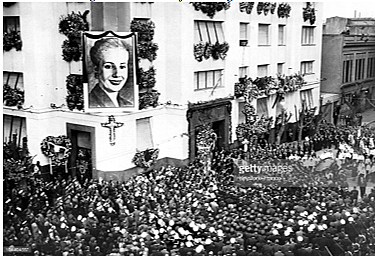
I agree with your comment that Evita became anhedonic after the lobotomy and although she kept on complaining of pain, accounts of the last few weeks of her life suggest that she was indeed indifferent to it, as well as to other activities, like eating. In regards to drinking, I suppose it is easier to force a patient to drink than to eat. In reference to the depression seen and felt in the coronal frontal region, I can tell you that it is not uncommon even with replacement of the bone discs or rondelles at the end of the operation, particularly when the bone if sutured to the skull with silk sutures rather than wire and/or, in these days, plates and screws. Today we complement the repair with acrylic just to prevent a cosmetic defect. Since Evita had a long forehead it is possible that Dr. Poppen might have accidentally placed the first hole a little too far back, and when he realized he was behind the coronal suture, he proceeded to do another one in front of it, as should be. As mentioned, the research progressed a lot after the confirmation of the trephinations and we have now several accounts by credible witnesses confirming that Evita had a lobotomy. I suppose people can still argue with me regarding the real objectives and purpose of having had her lobotomized at the end of her life. Cheers, Dan
______________
Thursday, June 7, 2018
Dear Dan,
Here I am giving you an introduction to Dr. Miguel Faria. Miguel, please take note that Dr. Nijensohn is impressed with your prolific writing on the many of same subjects that interest him. I am actually impressed with the writings of both of you.
Dan, in regards to this information, I will make a few comments on it later. As for Latin America, you are right. It is not an exception when looking at world corruption. It is there in every country, but perhaps to differing degrees. To some extent, it does seem like it is more visible in Central and South America, so it is hard to say sometimes just where the countries composing them should be ranked in a list of corruption of all countries. We could find quite a few lists on the internet, I am sure, but those kinds of lists I would not be apt to trust. As for Dr. Poppen, if he was the person who I have read he was, I do not think he would have gone ahead with the lobotomies on the prisoners if he knew that their crimes may have been no more than such as disagreeing with Juan Perón’s policies. What was Perón going to do to him? He could not treat a famous American neurosurgeon the same way he treated those prisoners. I think he would have had no choice but to let him leave Argentina. It is hard to classify Perón as a dictator, but he was a military man, and not averse to using very cruel methods if he thought they were justified. Yet, accusations of him being a Nazi sympathizer are probably not true. As Perón said, he simply borrowed anything he thought was good from any regime. He had no preferred type of rule to govern. Many will also say he was a “populist,” but it was much more than that. Some seem to think Evita was a fascist as well, but it is likely she was too uneducated and naïve to know what a fascist was. Did she even know that when she visited Spain, it was ruled by a fascist? Many don’t think so, and in any event Francisco Franco was one of the most benevolent of dictators who carried that label. Franco angered Hitler the same way Admiral Miklós Horthy of Hungary did by not releasing his Jewish population. Hitler did not think it wise to invade Spain the way he did Hungary. Concerning anhedonia, the return of psychosurgery, and why those rondelles were depressed and numbered more than two, I would like to get back to you. I am not a neurosurgeon, but I do think the explanation you give for the three or four rondelles and their depression in those days sounds likely. I had been thinking something happened that he had to immediately expose more of the brain, but that doesn’t seem to be the case. Incidentally, the picture below is that of Dr. Pedro Ara examining his work right after completion of the embalming of Evita Perón, an event which you mentioned earlier.
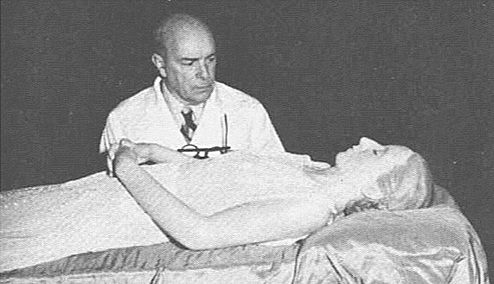
I will say that I am not disagreeing with you that Perón had her lobotomized to render her anhedonic to politics. But politics is a very high level conscious and logical abstract operation. As you mentioned earlier, something went wrong during that operation. Whatever it was, it extended the anhedonia to more basal impulses for survival. Also, yes, you are correct…to hydrate her would not be much of a problem compared to eating, if we assume she lost the desire to satisfy thirst, which is also very pleasurable when you are doing it. Without a CT or MRI (after rehydration measures that have worked very well in Egyptian mummies) we will never know. Even if we had the high resolution lateral plain film, it would not be enough. I was wrong to think that.
Now, I promised Dr. Faria about 2 or 2 ½ weeks ago I would write an online article for him on this subject. I have not yet submitted it because of various problems that have come up unrelated to it, but also because I have been concentrating on the history of the Perón regime… [This conversation negates the need for another article on the subject given the herculean job Dr. Nijensohn has already done on the subject. — Editor] This is the second communication you have sent me in response to mine, and I am deeply grateful… Thank you, doctor. Best Regards, Adam
Written by Dr. Daniel Nijensohn and Dr. Adam Bogart
Daniel E. Nijensohn, MD, MSc (Mayo Clinic, University of Minnesota), PhD, FACS, FAANS. He is Honorary Professor, Department of Neurosurgery, Yale University, New Haven, CT. Emeritus Chief of Neurosurgery, St. Vincent’s Medical Center; Honorary Staff, Section of Neurosurgery, Bridgeport Hospital; Past Staff Yale NH Hospital & Yale Gamma Knife Center.
Adam Bogart, PhD, is a Behavioral Neuroscientist at the Sanders Brown Center for Aging University of Kentucky, Lexington, KY. Behavioral Neuroscience Kent State University Kent, OH. Post doctoral fellow at the Albert Einstein College of Medicine, Gruss Magnetic Resonance Research Center Bronx, NY. MS Immunology conjointly Adelphi University/Mount Sinai Medical Center New York City, NY.
This article may be cited as: “A conversation between Drs. Daniel E. Nijensohn and Adam R. Bogart about Argentinean politics and Evita Perón’s secret lobotomy.” HaciendaPublishing.com, June 23, 2018. Available from: https://haciendapublishing.com/a-conversation-between-drs-daniel-e-nijensohn-and-adam-r-bogart-about-argentinean-politics-and-evita-perons-secret-lobotomy/.
Copyright ©2018 Hacienda Publishing, Inc.